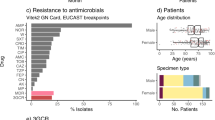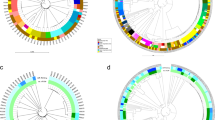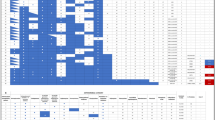Abstract
An outbreak of multi-resistant Serratia marcescens involving 24 patients occurred in a bone marrow transplant and oncology unit, from September 1998 to June 1999, of whom 14 developed serious infection. This is the first such outbreak described in a BMT unit. All isolates demonstrated the same antimicrobial susceptibility pattern and were the same unusual serotype O21:K14. The antimicrobial susceptibility profile showed reduced susceptibility to ciprofloxacin, gentamicin and piperacillin-tazobactam. As the latter two antimicrobials are part of our empiric therapy for febrile neutropenia, they were substituted with meropenem and amikacin during the outbreak. Investigation revealed breaches in infection control practices. Subsequently, the outbreak was contained following implementation of strict infection control measures. A prominent feature of the outbreak was prolonged carriage in some patients. These patients may have acted as reservoirs for cross-infection. This report also indicates that patients who become colonised with Serratia marcescens may subsequently develop invasive infection during neutropenic periods. Bone Marrow Transplantation (2000) 25, 873–877.
This is a preview of subscription content, access via your institution
Access options
Subscribe to this journal
Receive 12 print issues and online access
$259.00 per year
only $21.58 per issue
Buy this article
- Purchase on Springer Link
- Instant access to full article PDF
Prices may be subject to local taxes which are calculated during checkout


Similar content being viewed by others
References
Coleman D, Falkiner FR, Carr ME et al. Simultaneous outbreaks of infection due to Serratia marcescens in a general hospital J Hosp Infect 1984 5: 270–282
Vigeant P, Loo VG, Bertrand C et al. An outbreak of Serratia marcescens infections related to contaminated chlorhexidine Infect Control Hosp Epidemiol 1998 19: 791–794
Archibald LK, Corl A, Shah B et al. Serratia marcescens outbreak associated with extrinsic contamination of 1% chlorxylenol soap Infect Control Hosp Epidemiol 1997 18: 704–709
Beck-Sague CM, Jarvis WR . Epidemic bloodstream infections associated with pressure transducers: a persistent problem Infect Control Hosp Epidemiol 1989 10: 54–59
Vandenbroucke-Grauls C, Bars A, Visser M et al. An outbreak of Serratia marcescens traced to a contaminated bronchoscope J Hosp Infect 1993 23: 263–270
Herra CM, Knowles SJ, Kaufman ME et al. An outbreak of an unusual strain of Serratia marcescens in two Dublin hospitals J Hosp Infect 1998 38: 135–141
Sanders CC, Watanakunakorn C . Emergence of resistance to β-lactams, aminoglycosides and quinolones during combination therapy for infection due to Serratia marcescens J Infect Dis 1986 153: 617–619
Sanders WE, Sanders S . Inducible β-lactamases: clinical and epidemiological implication for use of newer cephalosporins Rev Infect Dis 1988 10: 830–838
Aucken HM, Wilkinson SG, Pitt TL . Identification of capsular antigens in Serratia marcescens J Clin Microbiol 1997 35: 59–63
Luzzaro F, Perilli M, Migliavacca R et al. Repeated epidemics caused by extended-spectrum β-lactamase-producing Serratia marcescens strains Eur J Clin Microbiol Infect Dis 1998 17: 629–636
Schaberg DR, Alford RH, Anderson R et al. An outbreak of nosocomial infection due to multiply resistant Serratia marcescens: evidence of interhospital spread J Infect Dis 1976 134: 181–188
Simor AE, Ramage L, Wilcox L et al. Molecular and epidemiologic study of multiresistant Serratia marcescens infections in a spinal cord injury rehabilitation unit Infect Control Hosp Epidemiol 1988 9: 20–27
Maki G, Hennekens C, Phillips C et al. Nosocomial urinary tract infection with Serratia marcescens: an epidemiologic study J Infect Dis 1973 128: 579–587
Van Ogtrop ML, van Zoeren-Grobben D, Verbakel-Salomons EMA, van Boven CPA . Serratia marcescens infections in neonatal departments: description of an outbreak and review of the literature J Hosp Infect 1997 36: 95–103
Livermore DM . β-Lactamases in laboratory and clinical resistance Clin Microbiol Rev 1995 8: 557–584
EORTC International Antimicrobial Therapy Cooperative Group . Gram-positive bacteraemia in granulocytopenic cancer patients Eur J Cancer 1990 26: 569–574
Author information
Authors and Affiliations
Rights and permissions
About this article
Cite this article
Knowles, S., Herra, C., Devitt, E. et al. An outbreak of multiply resistant Serratia marcescens: the importance of persistent carriage. Bone Marrow Transplant 25, 873–877 (2000). https://doi.org/10.1038/sj.bmt.1702218
Received:
Accepted:
Published:
Issue Date:
DOI: https://doi.org/10.1038/sj.bmt.1702218
Keywords
This article is cited by
-
Outbreaks of infectious diseases in stem cell transplant units: a silent cause of death for patients and transplant programmes
Bone Marrow Transplantation (2004)
-
The risk of persistent carriage of methicillin-resistant Staphylococcus aureus in hematopoietic stem cell transplantation
Annals of Hematology (2003)



